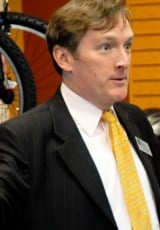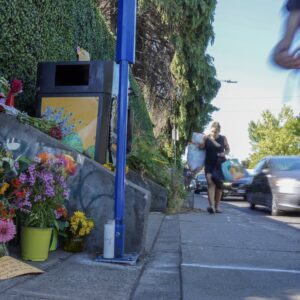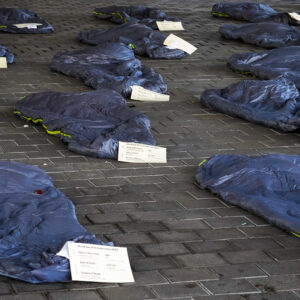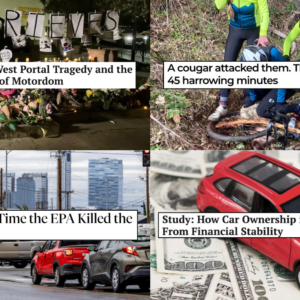With momentum surging for the Columbia River Crossing and what could be a pivotal Project Sponsor’s Council meeting just hours away, Portland Mayor Sam Adams and Metro President David Bragdon have issued a joint “Guiding Policy Statement” calling for “fundamental changes” in how the project is planned.
“A change in direction is needed for the CRC project to be successfully accomplished”
The statement makes it clear that Adams and Bragdon — who both have veto power on the project — are prepared to stymie the project unless there’s a major shift in the planning process. The statement fleshes out a position that Bragdon and Adams alluded to in an article published on the Portland Mercury blog earlier today.
The opening line of the statement lays out their position: “A change in direction is needed for the CRC project to be successfully accomplished”. The two leaders feel the project is “mired in financial challenges” and frame their position on wanting to solve those funding challenges in time for being eligible for federal funds.
Adams and Bragdon are very careful to not make it seem like they want to kill the CRC project altogether. In fact, they seem to be calling for just the opposite. The statement itself is titled, Columbia River Crossing: Road to Construction and Adams and Bragdon distance themselves from recent calls from a coalition of advocacy groups to start the project over, saying:
“In addition, it is important to underscore that we reject calls from project opponents to cancel or “restart” the project, as too much solid work has already been done.”
Adams and Bragdon are smart enough to know that calling for a re-do at this point is political suicide. With this project getting some recent momentum, and with our economy and unemployment numbers in the tank, they simply must be seen as supportive partners. It’s a very tricky balance for two leaders with many constituents who want them to come out completely against the project.
Also evident in the statement is that Adams and Bragdon are stalling for more time. They say recent project changes (“refinements” that trimmed 15% from the total project cost) lack adequate analysis. Specifically, they call out that the “refinements” were not analyzed according to specific guidelines laid out by the Performance Measures Advisory Group (a committee formed as a bone to Adams as part of a compromise for getting his support of a 12-lane bridge).
“We believe the current proposal contains incomplete and potentially flawed assumptions underlying the original proposal, particularly assumptions about demand forecasts, tax and toll revenues available for the project, and what those revenues can buy… we need to see performance-based criteria used to guide reconfiguration of the project, as the PSC has requested.”
Toward the end of the statement, Adams and Bragdon make it clear that they want the Departments of Transportation to play a less significant role in planning the bridge and that they want the Project Sponsor’s Council (PSC, which they are both members of) to step in and work more closely with CRC staff.
“We are proposing that PSC agency staff work directly with CRC project staff in a short, defined window to continue the current refinement work to create a realistic road to construction that includes:
1. A reliable budget based on realistic revenue projections;
2. A realistic assessment of the relationship between tolls, updated demand forecasts, desired land use patterns and size of the CRC facilities
3. Project elements that are firmly based in performance outcomes
4. Recognition that the interstate system must function in concert with local systems”
So far, the DOTs have played a huge role in driving this project. Adams and Bragdon are well aware that DOTs tend to be highway-centric and less attuned to community concerns. By shifting planning power to the Sponsor’s Council and CRC project staff, Adams and Bragdon feel they are more likely to come up with a bridge design that will be more palatable to them and, more importantly, to their constituents.
This statement will be seen as a blow to Governor Kulongoski. Just yesterday, Kulongoski commandeered a tugboat and invited the media for a press conference on the Columbia River to underscore what he sees as an urgent need to get this project done. That media strategy paid off with an editorial published this afternoon by The Oregonian saying the Project Sponsor’s Council “should move this long-sought project into the fast lane, speeding toward reality.”
I’m not sure of the technicalities, but I assume this “Guiding Policy Statement” could be proposed by Adams or Bragdon at the meeting tomorrow. If adopted, it would mean any major decision on starting the CRC project could be months away. There are crucial federal funding deadlines on the horizon. If the many players at the table can’t reach a consensus in time, the project might never see the light of day.
Are Adams and Bragdon just stalling in hopes that the CRC misses crucial funding windows, and therefore never gets built? Or, are they sincere and just taking a prudent detour on the “road to construction”?
Stay tuned for more twists and turns in the CRC saga and coverage from tomorrow’s Project Sponsor’s Council meeting.
Browse all our CRC coverage here.









Thanks for reading.
BikePortland has served this community with independent community journalism since 2005. We rely on subscriptions from readers like you to survive. Your financial support is vital in keeping this valuable resource alive and well.
Please subscribe today to strengthen and expand our work.
Transcribed from the House Transportation Committee meeting from the 19 of November:
“It is criminal to delay, obstruct, and in some people’s opinions, deny and prohibit this project from going forward. Every single day, that we wait is one more day those workers in America aren’t providing for their families and paying taxes to educate, medicate and incarcerate people in this country and in this region. And, I’m just, I’m done, I don’t need another public meeting, the next time I see you good people before us, I hope we’re talking about how we’re going in the project. I don’t need another public meeting. And we’re not going to get everybody’s vote and not everybody is going to agree. We don’t need everyone’s agreement and we don’t need everyone’s vote, we need to build this bridge, and move on. Thank you for coming.” – State Representative Michael Schaufler (D-Happy Valley, District 48)
I really hope that the prospect for jobs does not cloud our decision-making on this project, which I fear is currently the case.
Thanks for this piece!
It’s criminal to rush, hurry, construct and in some people’s opinions permit this project from going forward. Every single lane that we add is one more way those workers in America aren’t able to provide for their families due to the taxes they pay, taxes which otherwise would educate, medicate, (and in some cases) incarcerate people in this country and in this region. And I’m also done – I don’t need another meeting of private interests – the next time I see you good people before us, I hope we’re talking about how we’re NOT going ahead with the project. We don’t need more meetings – we’ve already gotten everybody’s vote and not everyone is going to agree. We need everyone’s participation and we need everyone’s vote, we need to NOT build this bridge, and move on. Thank you for staying. – Matt Picio, and every other sane, rational human in the region.
Nice to know that Happy Valley still has backward-looking politicians who aren’t afraid to speak their views. It’s a lot easier to fight narrow-mindedness, poor planning and dis-inclusiveness when it’s voiced so plainly and boldly for the world to see.
Go, Matt! See you at the meeting?
Perhaps the analysis proposed will measure and balance the two (often contradictory) forces at play:
-transportation investments that provide current construction jobs and
– also reinforces into the future existing development patterns that do not reduce our region’s transportation fuel use or demand for automobiles (these two items are the bulk of our nation’s trade deficit).
Other CRC items in the news today:
http://www.columbian.com/article/20091204/OPINION02/712049964
[One citizen writing in suggests removing the underportion of the bridges and moving the SUP up between the bridges to save $. They do not understand that this would cost more money – as has been presented to the CRC PBAC.]
And our mayor elect has a guest article about the CRC in this week’s edition of the Portland Tribune:
http://www.portlandtribune.com/opinion/story.php?story_id=125979209879365700
From the beginning of the CRC I’ve had two questions:
1)Why must the current bridges be destroyed?
The I5 Bridges are structurally sound and with proper maitenance, they will last for decades more. Upgrades to meet current earthquake standards would cost a fraction of new bridge.
2)Where is the money to pay for a new bridge coming from?
Even with Federal funding and tolls, a new bridge represents a huge part of the future transportation budgets of both Washington and Oregon. Are the rural and eastern parts of these states really going to support a project of such cost to benefit the Portland/Vancouver metro region?
todd-thanks for the links to the crc articles.
i’m with tim on this. the current I-5 bridge hinders our regional economy and needs to be replaced. not only being antiquated and unsafe it has long been inadequate for our transportation needs.
for my day to day life i really do not need a new bridge but i can see the larger picture and the effects on the regional economy. consider the liberal bias of most of us cyclists who read this blog. as stated here in another article most right wing conservatives view cyclists as either spandex clad goofballs or hopped up hippies. such are your perceptions when your focus is narrow. i urge you to please consider the larger picture. looking beyond yourself and your own needs is sadly lacking in our society.
financial considerations are a major concern with the crc and the costs will only increase with time. the farther it’s pushed into the future the more it will cost and as the value of our dollar decreases we will get less for every dollar spent. can we really afford to delay this project? in a time when folks are screaming for fiscal reasonsibility in government please consider the $80 million+ (i think that is around what vancouver has spent so far, tood-if you have a firm # i’d like to know) that would be wasted if this project was to be killed and started over. yes, much of the info could be reused in a new project design but federal funding is hinged on timelines and progress. restarting from scratch only makes it more difficult to obtian federal dollars that are what the project needs to reach fruition. many of you have a problem with the sheer size and number of lanes involved but current economics will certainly decrease the scale of the project. feel free to pat yourselves on the back if you need.
i don’t ride a scooter and have no plan to but i did hear a suggestion that accomodations should be included for lower speed vehicles (electric/gas cars & scooters) that cannot achive freeway speeds but are not allowed on bike/ped paths. this mode of transportation is only going to increase so it makes sense to include them in the design. i have personally encountered several scooters and motorized bikes while cycling accross the I-5 bridge bike path. they are technically prohibited and i felt it was pretty sketchy but what other option do they have? not my chosen mode of transport but i can see it’s validity.
i hear many of you folks saying we don’t need a new bridge. other than the standard green drum thumping anti-car rehetoric i’ve not heard many opinions that reflect any consideration for viewpoints that differ from your own self centered opinion of how the world should be in your eyes. take a look around and consider everyone else, not just yourself.
Well here is a solution. Modernize the existing bridge, then add a freight lane on 205 from I-5/205 connection to Glen Jackson Bridge, then use the existing rail bridge for the light rail and pedestrian crossing. Does everything but bail out the people who made the bad choice of living and working in different states.
I’ve read Bragdon repeat the argument that the bridge needs to be replaced because it’s built on wooden pylons… and then I’ve read several folks here and elsewhere claim that the existing bridge can be fixed up cheaply… no problem.
Who’s right?
Many bridges are built on wooden pilings, typically they are Port Orford cedar which can last a hundreds of years. The process for redoing the pilings is not rocket science. A coffer dam is built around the base of the support using sheet piles, the water is pumped out. New pilings may be driven if needed for geotechnical reasons and concrete base is poured to tie the new pilings to the old columns. The central pivot in the Coos Bay rail bridge was completed this way several years ago. It is not rocket science, but it is a cool project.